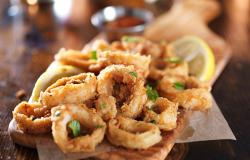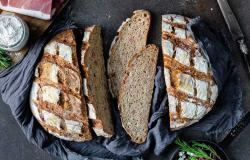Focaccia di Recco

When you think of focaccia, chances are that slices of thick, dimpled and generously oiled leavened bread anointed with salt crystals – a specialty of the historic port city of Genoa - come to mind. Yet, focaccehave been made in Liguria and along the Italian peninsula since Roman times. Subsequently, you'll find the name focaccia used to describe a great variety of locally-produced rustic breads which differ considerably in shape, size and toppings all along the sunkissed, mountainous region straddling Italy's northwestern coast. There's the piscialandrea, a relative of Nice's anchovy and onion-topped pissaladière, thought to be named after the Genoese admiral, Andrea Doria. There are focaccia con le cipolle and focaccia alle olive,made with onion and olives, respectively. My personal favourite, however, would have to be a rather atypical, unleavened variety from the town of Recco, near Genoa.
Traditionally a specialty reserved for All Saints Day celebrations, a fugassa cö formaggio (meaning 'focaccia with cheese' in the local dialect) won over the growing flock of summer visitors to the Ligurian coast in the 1950s with its uniqueness and simplicity: a generous layer of oozing, melted soft cheese sandwiched between two transparent, paper-thin layers of dough. Recco's bakers and trattoria owners responded in kind to this newfound demand for their irresistibly cheesy delight by baking it year round. Over the years, Recco's fugassa cö formaggio has become such a revered delicacy in Italy that it was granted IGP (protected geographical indication) status by the European Union in 2012.
Legend has it that this iconic focaccia has its origins during the Third Crusade. During the late 1100s, the citizens of Recco found refuge in Liguria's mountainous hinterland while the Saracens raided the coast. There, they created this three layered flatbread with the few ingredients they had on hand – flour, water, olive oil, salt and cheese. It has been made with the exact same ingredients ever since, although the more traditional cheeses - Formaggetta and Prescinsêua – have given way to Stracchino and Crescenza in recent times.
The beauty of making this delightfully good focaccia at home lies in the fact that it makes use of basic Italian pantry staples – flour, water, salt and extra virgin olive oil. Stretching the dough to the required paper-thin transparency, however, does take some practice. Rest assured though, it does get easier! Here's a link to a very instructive (Italian-language, but clear) YouTube video on how to perform this delicate task. To facilitate the stretching, it also helps to have a high protein, strong bread flour on hand, which gives dough greater elasticity than plain, all-purpose flour.
A final note, this time regarding baking temperature. Professional bakers generally bake this focacciain virtually no time in very high heat ovens. To obtain a perfectly crisp and golden brown surface, you're also encouraged to bake your cheesy focacciaat the highest temperature your domestic oven can reach. Mine goes up to 275 º C and I'm generally satisfied with its appearance after 5-6 minutes. If your oven doesn't reach this temperature, you may find baking it takes a little longer.
Ingredients (for two round trays measuring 26-28 cm)
Place the flour and 6 g salt in a large mixing bowl. Form a well in the middle and add the water and the extra virgin olive oil. With a fork, bring the flour and liquid ingredients together until combined. Transfer the dough to a clean, lightly dusted wooden work surface. Knead until the dough is smooth and elastic, about 5-6 minutes. Cover tightly with plastic wrap and leave to rest for at least an hour in the fridge.
Divide the dough into two equally-sized pieces. Keep one the dough balls covered in plastic wrap and roll out the other one with a rolling pin on lightly-dusted work surface. Keep it as round and as thin as possible while rolling, then take it in your hands and stretch it very carefully to obtain the required transparency. Use the weight that accumulates at the stretched dough's edges to help you. Your sheet of dough is ready once you can easily see the outline of our hands through the dough and it has a larger circumference than your round baking tray. Carefully lay it down on one of your lightly-greased round baking trays. Place spoonfuls of Crescenza or Stracchino cheese over your transparent sheet of dough.
Unwrap the remaining piece of dough. Roll and stretch again as detailed above. Lay this transparent sheet over the spoonfuls of cheese. Run a non-serrated knife or pastry wheel around the edges of your baking tray to remove the excess dough. Using your fingers, go around the edges of your focaccia again to create a seal between the two dough layers. Gather the excess dough and set aside for rolling into your second focaccia. Pinch holes into the top layer of dough to allow steam to come out during cooking. Sprinkle with a pinch of fine sea salt and drizzle and brush with some extra virgin olive oil.
Bake in an oven preheated to its highest possible temperature (this can range from 240 to 280 º C in most domestic ovens) for about 5-6 minutes, or until golden brown and the cheese melts. Remove from the oven, slice and serve piping hot as a snack or an appetiser to a meal.






